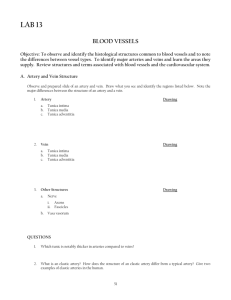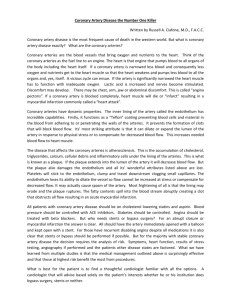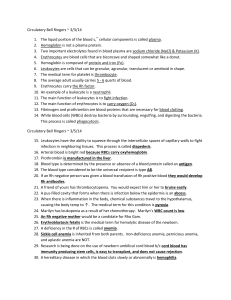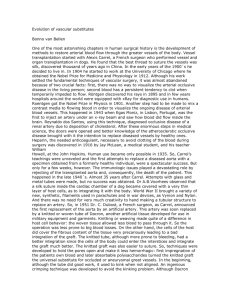Peripheral Artery Disease
advertisement
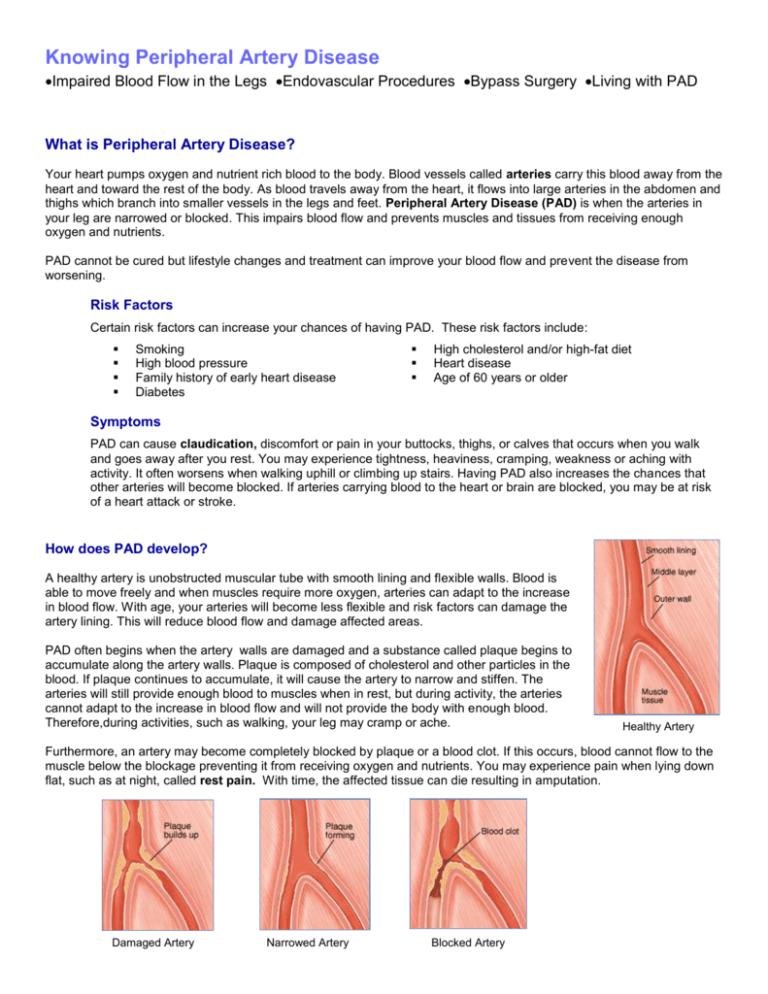
Knowing Peripheral Artery Disease Impaired Blood Flow in the Legs Endovascular Procedures Bypass Surgery Living with PAD What is Peripheral Artery Disease? Your heart pumps oxygen and nutrient rich blood to the body. Blood vessels called arteries carry this blood away from the heart and toward the rest of the body. As blood travels away from the heart, it flows into large arteries in the abdomen and thighs which branch into smaller vessels in the legs and feet. Peripheral Artery Disease (PAD) is when the arteries in your leg are narrowed or blocked. This impairs blood flow and prevents muscles and tissues from receiving enough oxygen and nutrients. PAD cannot be cured but lifestyle changes and treatment can improve your blood flow and prevent the disease from worsening. Risk Factors Certain risk factors can increase your chances of having PAD. These risk factors include: Smoking High blood pressure Family history of early heart disease Diabetes High cholesterol and/or high-fat diet Heart disease Age of 60 years or older Symptoms PAD can cause claudication, discomfort or pain in your buttocks, thighs, or calves that occurs when you walk and goes away after you rest. You may experience tightness, heaviness, cramping, weakness or aching with activity. It often worsens when walking uphill or climbing up stairs. Having PAD also increases the chances that other arteries will become blocked. If arteries carrying blood to the heart or brain are blocked, you may be at risk of a heart attack or stroke. How does PAD develop? A healthy artery is unobstructed muscular tube with smooth lining and flexible walls. Blood is able to move freely and when muscles require more oxygen, arteries can adapt to the increase in blood flow. With age, your arteries will become less flexible and risk factors can damage the artery lining. This will reduce blood flow and damage affected areas. PAD often begins when the artery walls are damaged and a substance called plaque begins to accumulate along the artery walls. Plaque is composed of cholesterol and other particles in the blood. If plaque continues to accumulate, it will cause the artery to narrow and stiffen. The arteries will still provide enough blood to muscles when in rest, but during activity, the arteries cannot adapt to the increase in blood flow and will not provide the body with enough blood. Therefore,during activities, such as walking, your leg may cramp or ache. Healthy Artery Furthermore, an artery may become completely blocked by plaque or a blood clot. If this occurs, blood cannot flow to the muscle below the blockage preventing it from receiving oxygen and nutrients. You may experience pain when lying down flat, such as at night, called rest pain. With time, the affected tissue can die resulting in amputation. Damaged Artery Narrowed Artery Blocked Artery What test will I need? In order to determine whether you have PAD and if so, the severity, your doctor will need to perform an evaluation. Your evaluation will include a patient history and exam. Your doctor will ask you about your general health, medical history, and symptoms. Be sure to tell your doctor about your medications, including aspirin, blood thinners and herbs. During your physical exam, your doctor will feel for pulses and listen to blood flow in your major arteries. He or she will examine your feet and legs for signs of PAD which include nail problems, changes in color and temperature and sores that do not heal. In addition, you will have tests to measure blood flow in your legs and feet. They are often short and painless. They include: Ankle-brachial index (ABI): This test compares the blood pressure in your ankle with the blood pressure in your arm. Duplex Ultrasound: This test looks at blood flow in your arteries and can detect changes due to artery narrowing or blocking. If your doctor suspects you have PAD, you may have more tests to reveal the amount of damage in an artery and its location. Arteriography: X-rays help locate where the artery has narrowed or been blocked. The procedure uses a long, thin tube called a catheter which is inserted into an artery usually in your groin and guided to the affected artery. Once in place, the catheter is used to inject a contrast dye into the artery. The contrast dye allows blood flow to be easily seen on x-rays. Arteriograms, or images, are taken. CT arteriography: This imaging test uses computer-generated x-rays to create detailed images of the arteries. MR arteriography: This test uses a magnet and radio waves to show images of blood flow in the arteries. Treatment In determining your best treatment plan, your doctor takes into consideration the number of affected arteries, the site and severity. General health and your kidney function are also factors. Your doctor will recommend making changes in your lifestyle to prevent symptoms from worsening. Medication and treatment are often necessary to improve symptoms. Endovascular Procedures Endovascular procedures are used to treat severely narrowed arteries or short blockages. These procedures are minimally invasive and use only small punctures, not incisions. Therefore, the recovery is quicker and there are fewer complications. Endovascular procedures include angioplasty and stenting. First, an angioplasty is performed to widen a narrowed artery or clear a blockage. And then, a stent may be used in order to keep the artery open. Angioplasty Angioplasty uses a small balloon to clear blocked arteries. A balloon-tipped catheter is inserted into the artery and guided to the narrowing or blockage. The small balloon is then inflated and deflated multiple times to flatten the plaque against the artery walls. When the artery is cleared, the balloon is deflated and removed. Blood flow can now return to normal. Stenting Stenting is when a tiny wire mesh tube is inserted into the artery to keep the artery open. A collapsed stent is placed on a balloon catheter and threaded across the blockage. The balloon is then inflated to open the stent. The stent is locked into place in the artery. The balloon is deflated and removed while the stent stays in place keeping the artery open. Bypass Surgery In order to treat longer or more severe blockages, you may need open surgery. Bypass surgery uses a graft to create a new pathway for blood around a blocked artery in the abdomen or leg. The graft may be a synthetic tube or a vein from your leg. The blood is then rerouted and the damaged section of the artery is not removed. Abdominal Bypass A bypass surgery may be needed if the abdominal aorta is blocked. The abdominal aorta is a large artery in the abdomen. Your surgeon will make incisions in the abdomen and groin, and sew a synthetic graft into the artery above and below the blockage. Once blood flows through the graft, the incisions are closed. Leg Bypass A leg bypass surgery uses a graft to restore blood flow from the femoral artery in your thigh to arteries further down the leg. There are two common types of leg bypasses performed. A femoral popliteal bypass is used for the upper leg and reroutes the popliteal artery behind the knee. A distal bypass is used for the lower leg and reroutes the artery below the knee. Often a healthy vein is used to bypass a blocked leg artery. The vein may be removed through one long incision or several short ones. Other times, a synthetic graft or combination of the two is used. You surgeon will make an incision near the blocked artery and attach the graft above and below the blockage. Once blood flows through the graft, the incisions are closed. Femoral popliteal bypass Distal bypass How to live healthier with PAD By living a healthier life, you can slow the development PAD and improve the health of your arteries. This can reduce the likelihood of a heart attack or stroke. Changes you can make include: Keep Follow-Up appointments: During your appointments, your doctor can check blood flow and make sure your graft is functioning properly. If any problems arise, your doctor will be able to discover them and treat them right away. Exercise: By exercising daily you can improve blood flow and lower blood pressure. Start off slow, and increase your distance a little each day. Healthy Diet: By eating healthy foods, you can prevent plaque buildup and reduce blood pressure and cholesterol levels. Healthy changes include: o Limiting your fats, red meat, dairy products and processed food o Eating at least five servings of fruits and vegetables o Baking, broiling or steaming your foods o Eating smaller proportions. Manage any health problems: To keep your arteries healthy, try to manage your other health problems. Discuss how to best control diabetes, high blood pressure, high cholesterol, or heart disease. If you smoke, quit! : Smoking a great risk factor for PAD because it damages artery wall and interferes with blood flow.





